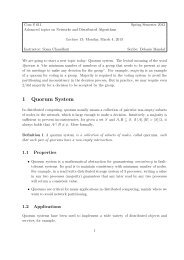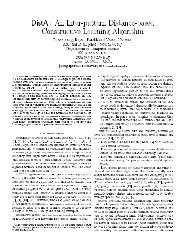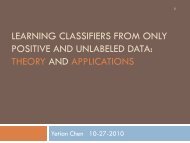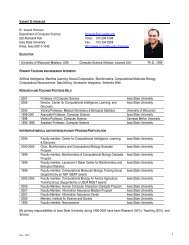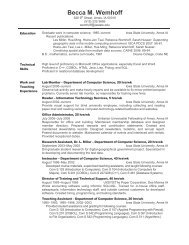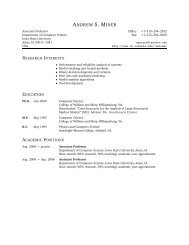Quaternions and Rotations∗ - Iowa State University
Quaternions and Rotations∗ - Iowa State University
Quaternions and Rotations∗ - Iowa State University
You also want an ePaper? Increase the reach of your titles
YUMPU automatically turns print PDFs into web optimized ePapers that Google loves.
<strong>Quaternions</strong> <strong>and</strong> Rotations ∗<br />
(Com S 477/577 Notes)<br />
Yan-Bin Jia<br />
Sep 20, 2010<br />
1 Introduction<br />
The development of quaternions is attributed to W. R. Hamilton in 1843. Legend has it that<br />
Hamilton was walking with his wife Helen at the Royal Irish Academy when he was suddenly<br />
struck by the idea of adding a fourth dimension in order to multiply triples. Excited by this<br />
breakthrough, as the couple passed the Broome Bridge of the Royal Canal, he carved the newfound<br />
quaternion equations<br />
i 2 = j 2 = k 2 = ijk = −1<br />
into the stone of the bridge. This event is marked by a plaque at the exact location today. Hamilton<br />
spent the rest of his life working on quaternions, which became the first non-commutative algebra<br />
to be studied.<br />
Up until now we have learned that a rotation in R 3 about an axis through the origin can be<br />
represented by a 3 × 3 orthogonal matrix with determinant 1. However, the matrix representation<br />
seems redundant because only four of its nine elements are independent. Also the geometric interpretation<br />
of such a matrix is not clear until we carry out several steps of calculation to extract the<br />
rotation axis <strong>and</strong> angle. Furthermore, to compose two rotations, we need to compute the product<br />
of the two corresponding matrices, which requires twenty-seven multiplications <strong>and</strong> eighteen<br />
additions.<br />
<strong>Quaternions</strong> are very efficient for analyzing situations where rotations in R 3 are involved. A<br />
quaternion is a 4-tuple, which is a more concise representation than a rotation matrix. Its geometric<br />
meaning is also more obvious as the rotation axis <strong>and</strong> angle can be trivially recovered. The<br />
quaternion algebra to be introduced will also allow us to easily compose rotations. This is because<br />
quaternion composition takes merely sixteen multiplications <strong>and</strong> twelve additions.<br />
2 Quaternion Algebra<br />
The set of quaternions, together with the two operations of addition <strong>and</strong> multiplication, form a<br />
non-commutative ring. 1 The st<strong>and</strong>ard orthonormal basis for R 3 is given by three unit vectors<br />
∗ Sections 2–6 are based on Chapters 3–6 of the book [7] by J. B. Kuipers, <strong>and</strong> Sections 1 (partially) <strong>and</strong> 7 are<br />
based on the essay by S. Oldenburger [6] who took the course.<br />
1 For the purpose of this course, you don’t really need to know what a ring is although it can be found in a st<strong>and</strong>ard<br />
algebra text such as the book by Hungerford [4] or Jacobson [5].<br />
1
i = (1,0,0), j = (0,1,0), k = (0,0,1). A quaternion q is defined as the sum of a scalar q 0 <strong>and</strong> a<br />
vector q = (q 1 ,q 2 ,q 3 ); namely,<br />
2.1 Addition <strong>and</strong> Multiplication<br />
q = q 0 + q = q 0 + q 1 i + q 2 j + q 3 k.<br />
Addition of two quaternions acts componentwise. More specifically, consider the quaternion q above<br />
<strong>and</strong> another quaternion<br />
p = p 0 + p 1 i + p 2 j + p 3 k.<br />
Then we have<br />
p + q = (p 0 + q 0 ) + (p 1 + q 1 )i + (p 2 + q 2 )j + (p 3 + q 3 )k.<br />
Every quaternion q has a negative −q with components −q i , i = 0,1,2,3.<br />
The product of two quaternions satisfies these fundamental rules introduced by Hamilton:<br />
i 2 = j 2 = k 2 = ijk = −1,<br />
ij = k = −ji,<br />
jk = i = −kj,<br />
ki = j = −ik.<br />
Now we can give the product of two quaternions p <strong>and</strong> q:<br />
pq = (p 0 + p 1 i + p 2 j + p 3 k)(q 0 + q 1 i + q 2 j + q 3 k)<br />
= p 0 q 0 − (p 1 q 1 + p 2 q 2 + p 3 q 3 ) + p 0 (q 1 i + q 2 j + q 3 k) + q 0 (p 1 i + p 2 j + p 3 k)<br />
+(p 2 q 3 − p 3 q 2 )i + (p 3 q 1 − p 1 q 3 )j + (p 1 q 2 − p 2 q 1 )k.<br />
Whew! It is too long to remember or even to underst<strong>and</strong> what is going on. Fortunately, we can<br />
utilize the inner product <strong>and</strong> cross product of two vectors in R 3 to write the above quaternion<br />
product in a more concise form:<br />
pq = p 0 q 0 − p · q + p 0 q + q 0 p + p × q. (1)<br />
In the above, p = (p 1 ,p 2 ,p 3 ) <strong>and</strong> q = (q 1 ,q 2 ,q 3 ) are the vector parts of p <strong>and</strong> q, respectively.<br />
Example 1. Suppose the two vectors are given as follows:<br />
p = 3 + i − 2j + k,<br />
q = 2 − i + 2j + 3k.<br />
We single out their vector parts p = (1, −2, 1) <strong>and</strong> q = (−1, 2, 3) <strong>and</strong> calculate their inner <strong>and</strong> cross products:<br />
p · q = −2,<br />
i j k<br />
p × q =<br />
1 −2 1<br />
∣ −1 2 3 ∣<br />
= −8i − 4j.<br />
2
By (1) the quaternion product is then<br />
pq = 6 − (−2) + 3(−i + 2j + 3k) + 2(i − 2j + k) + (−8i − 4j)<br />
= 8 − 9i − 2j + 11k.<br />
We see that the product of two quaternions is still a quaternion with scalar part p 0 q 0 −p·q <strong>and</strong><br />
vector part p 0 q + q 0 p + p × q. The set of quaternions is closed under multiplication <strong>and</strong> addition.<br />
It is not difficult to verify that multiplication of quaternions is distributive over addition. The<br />
identity quaternion has real part 1 <strong>and</strong> vector part 0.<br />
2.2 Complex Conjugate, Norm, <strong>and</strong> Inverse<br />
Let q = q 0 + q = q 0 + q 1 i + q 2 j + q 3 k be a quaternion. The complex conjugate of q, denoted q ∗ , is<br />
defined as<br />
q ∗ = q 0 − q = q 0 − q 1 i − q 2 j − q 3 k.<br />
From the definition we immediately have<br />
(q ∗ ) ∗ = q 0 − (−q) = q,<br />
q + q ∗ = 2q 0 ,<br />
q ∗ q = (q 0 − q)(q 0 + q)<br />
= q 0 q 0 − (−q) · q + q 0 q + (−q)q 0 + (−q) × q by (1)<br />
= q 2 0 + q · q<br />
= q 2 0 + q2 1 + q2 2 + q2 3<br />
= qq ∗ .<br />
Given two quaternions p <strong>and</strong> q, we can easily verify that<br />
(pq) ∗ = q ∗ p ∗ . (2)<br />
The norm of a quaternion q, denoted by |q|, is the scalar |q| = √ q ∗ q. A quaternion is called a<br />
unit quaternion if its norm is 1. The norm of the product of two quaternions p <strong>and</strong> q is the product<br />
of the individual norms, for we have<br />
|pq| 2<br />
= (pq)(pq) ∗<br />
= pqq ∗ p ∗<br />
= p|q| 2 p ∗<br />
= pp ∗ |q| 2<br />
= |p| 2 |q| 2 .<br />
The inverse of a quaternion q is defined as<br />
q −1 = q∗<br />
|q| 2.<br />
We can easily verify that q −1 q = qq −1 = 1. In the case q is a unit quaternion, the inverse is its<br />
conjugate q ∗ .<br />
3
3 Quaternion Rotation Operator<br />
How can a quaternion, which lives in R 4 , operate on a vector, which lives in R 3 ? First, we note<br />
that a vector v ∈ R 3 is a pure quaternion whose real part is zero. Let us consider a unit quaternion<br />
q = q 0 + q only. That q 2 0 + ‖q‖2 = 1 implies that there must exist some angle θ such that<br />
cos 2 θ = q 2 0 ,<br />
sin 2 θ = ‖q‖ 2 .<br />
In fact, there exists a unique θ ∈ [0,π] such that cos θ = q 0 <strong>and</strong> sin θ = ‖q‖. The unit quaternion<br />
can now be written in terms of the angle θ <strong>and</strong> the unit vector u = q/‖q‖:<br />
q = cos θ + usin θ.<br />
Pure <strong>Quaternions</strong><br />
R<br />
3<br />
v<br />
v = 0 + v<br />
R<br />
4<br />
<strong>Quaternions</strong><br />
Using the unit quaternion q we define an operator on vectors v ∈ R 3 :<br />
L q (v) = qvq ∗<br />
= (q 2 0 − ‖q‖ 2 )v + 2(q · v)q + 2q 0 (q × v). (3)<br />
Here we make two observations. First, the quaternion operator (3) does not change the length of<br />
the vector v for<br />
‖L q (v)‖<br />
= ‖qvq ∗ ‖<br />
= |q| · ‖v‖ · |q ∗ |<br />
= ‖v‖.<br />
Second, the direction of v, if along q, is left unchanged by the operator L q . To verify this, we let<br />
v = kq <strong>and</strong> have<br />
qvq ∗<br />
= q(kq)q ∗<br />
= (q0 2 − ‖q‖ 2 )(kq) + 2(q · kq)q + 2q 0 (q × kq)<br />
= k(q0 2 + ‖q‖2 )q<br />
= kq.<br />
The two observations make us guess that the operator L q acts like a rotation about q. This is made<br />
precise by the next theorem.<br />
Before proceeding with the theorem, we remark that the operator L q is linear over R 3 . For any<br />
two vectors v 1 ,v 2 ∈ R 3 <strong>and</strong> any a 1 ,a 2 ∈ R we can show that<br />
L q (a 1 v 1 + a 2 v 2 ) = a 1 L q (v 1 ) + a 2 L q (v 2 ).<br />
4
Theorem 1 For any unit quaternion<br />
<strong>and</strong> for any vector v ∈ R 3 the action of the operator<br />
q = q 0 + q = cos θ 2 + u sin θ 2 , (4)<br />
L q (v) = qvq ∗<br />
on v is equivalent to a rotation of the vector through an angle θ about u as the axis of rotation.<br />
Proof Given a vector v ∈ R 3 , we decompose it as v = a + n, where a is the component along<br />
the vector q <strong>and</strong> n is the component normal to q. Then we show that under the operator L q , a is<br />
invariant, while n is rotated about q through an angle θ. Since the operator is linear, this shows<br />
that the image qvq ∗ is indeed interpreted as a rotation of v about q through an angle θ.<br />
We know from an early reasoning that a is invariant under L q . So let us focus on the effect of<br />
L q on the orthogonal component n. We have<br />
L q (n) = (q 2 0 − ‖q‖2 )n + 2(q · n)q + 2q 0 (q × n)<br />
= (q 2 0 − ‖q‖2 )n + 2q 0 (q × n)<br />
= (q 2 0 − ‖q‖2 )n + 2q 0 ‖q‖(u × n),<br />
where in the last step above we introduced u = q/‖q‖. Denote n ⊥ = u × n. So the last equation<br />
becomes<br />
L q (n) = (q 2 0 − ‖q‖ 2 )n + 2q 0 ‖q‖n ⊥ . (5)<br />
Note that n ⊥ <strong>and</strong> n have the same length:<br />
‖n ⊥ ‖ = ‖n × u‖ = ‖n‖ · ‖u‖sin π 2 = ‖n‖.<br />
Finally, we rewrite (5) into the form<br />
(<br />
L q (n) = cos 2 θ 2 − θ ) (<br />
sin2 n + 2cos θ 2 2 sin θ )<br />
n ⊥<br />
2<br />
= cos θn + sin θn ⊥ .<br />
Namely, the resulting vector is a rotation of n through an angle θ in the plane defined by n <strong>and</strong><br />
n ⊥ . See the figure below. This vector is clearly orthogonal to the rotation axis.<br />
n<br />
L q ( n)<br />
θ<br />
q<br />
n<br />
5
We substitute the unit quaternion form (4) into (3) to obtain the resulting vector from rotating<br />
a vector v about the axis u through θ:<br />
(<br />
L p (v) = cos 2 θ 2 − θ )<br />
sin2 v + 2<br />
(usin θ )<br />
2 2 · v usin θ 2 + 2cos θ (usin θ )<br />
2 2 × v<br />
= cos θ · v + (1 − cos θ)(u · v)u + sinθ · (u × v). (6)<br />
Example 2. Consider a rotation about an axis defined by (1, 1, 1) through an angle of 2π/3. About this<br />
axis, the basis vectors i, j, <strong>and</strong> k generate the same cone when rotated through 2π. We define a unit vector<br />
u = 1 √<br />
3<br />
(1, 1, 1).<br />
Let the rotation angle θ = 2π/3. The quaternion q defines the rotation is then given as<br />
v = − 1 ⎝ 1 0 ⎠ +<br />
2<br />
0<br />
⎛<br />
− 1 ⎞ ⎛<br />
2<br />
= ⎝ 0 ⎠ ⎜<br />
+ ⎝<br />
0<br />
q = cos θ 2 + usin θ 2<br />
= 1 2 + 1 2 i + 1 2 j + 1 2 k.<br />
Let us compute the effect of rotation on the basis vector i = (1, 0, 0). We obtain the resulting vector<br />
using (6):<br />
⎛ ⎞<br />
⎛<br />
(<br />
1 + 1 )<br />
1 1<br />
· √ · √ ⎝ 1 ⎞ ⎛<br />
√<br />
1 ⎠ 3<br />
+<br />
2 3 3 2 · 1<br />
√ ⎝ 1 ⎞ ⎛<br />
1 ⎠ × ⎝ 1 ⎞<br />
0 ⎠<br />
1 3 1 0<br />
⎞ ⎛ ⎞<br />
= j.<br />
1<br />
2<br />
1<br />
2<br />
1<br />
2<br />
⎟ ⎜<br />
⎠ + ⎝<br />
0<br />
1<br />
2<br />
− 1 2<br />
⎟<br />
⎠<br />
The rotation of v under the operator L q can also be interpreted from the perspective of an<br />
observer attached to the vector v. What he sees happening is that the coordinate frame rotates<br />
through the angle −θ about the same axis defined by the quaternion.<br />
Theorem 2 For any unit quaternion<br />
q = q 0 + q = cos θ 2 + u sin θ 2 ,<br />
<strong>and</strong> for any vector v ∈ R 3 the action of the operator<br />
L q ∗(v) = q ∗ v(q ∗ ) ∗ = q ∗ vq<br />
is a rotation of the coordinate frame about the axis u through an angle θ while v is not rotated.<br />
Equivalently, the operator L q ∗ rotates the vector v with respect to the coordinate frame through<br />
an angle −θ about q.<br />
The quaternion operator L q (v) = qvq ∗ may be interpreted as a point or vector rotation with<br />
respect to the (fixed) coordinate frame. The quaternion operator L q ∗(v) = q ∗ vq may be interpreted<br />
as a coordinate frame rotation with respect to the (fixed) space of points.<br />
6
4 Quaternion Operator Sequences<br />
Let p <strong>and</strong> q be two unit quaternions. We first apply the operator L p to the vector u <strong>and</strong> obtain<br />
the vector v. To v we then apply the operator L q <strong>and</strong> obtain the vector w. Equivalently, we apply<br />
the composition L q ◦ L p of the two operators:<br />
w = L q (v)<br />
= qvq ∗<br />
= q(pup ∗ )q ∗<br />
= (qp)u(qp) ∗<br />
= L qp (u).<br />
Because p <strong>and</strong> q are unit quaternions, so is the product qp. Hence the above equation describes a<br />
rotation operator whose defining quaternion is the product of the two quaternions p <strong>and</strong> q. The<br />
axis <strong>and</strong> angle of the composite rotation is given by the product qp.<br />
Similarly, consider the quaternion operators L p ∗(u) = p ∗ up <strong>and</strong> L q ∗(v) = q ∗ vq which carry<br />
out rotations of the coordinate system determined by quaternions p <strong>and</strong> q, respectively. Then the<br />
quaternion product pq defines an operator L (pq) ∗, which represents a sequence of operators L p ∗<br />
followed by L q ∗. The axis <strong>and</strong> angle of rotation of L (pq) ∗ are those represented by the quaternion<br />
product pq.<br />
Example 3. We now use the quaternion method to find the axis <strong>and</strong> angle of the composite rotation in<br />
the Satellite tracking example from the notes titled “Space Rotations”. Recall that the tracking application<br />
takes a rotation about the z-axis through a bearing angle α followed by a rotation about the new y-axis<br />
through an elevation angle β. After these two rotations, the new x-axis points toward the satellite. The two<br />
rotations are respectively described by the two quaternions below:<br />
p = cos α 2 + sin α 2 k,<br />
q = cos β 2 + sin β 2 j.<br />
Since we are rotating the coordinate frame, the two operators L p ∗ <strong>and</strong> L q ∗ are applied sequentially. The<br />
composite rotation operator is L (pq) ∗, which transforms coordinates in the station frame to those in the<br />
tracking frame. And the quaternion describing the composition rotation is the product pq which is as<br />
follows.<br />
pq =<br />
(cos α 2 + sin α ) (<br />
2 k cos β 2 + sin β )<br />
2 j<br />
= cos α 2 cos β 2 + cos α 2 sin β 2 j + sin α 2 cos β 2 k + sin α 2 sin β (k × j)<br />
2<br />
= cos α 2 cos β 2 − sin α 2 sin β 2 i + cos α 2 sin β 2 j + sin α 2 cos β 2 k.<br />
The axis of the composite rotation is defined by the vector<br />
(<br />
v = − sin α 2 sin β 2 , cos α 2 sin β 2 , sin α 2 cos β )<br />
. (7)<br />
2<br />
And the angle of rotation θ satisfies<br />
cos θ 2<br />
sin θ 2<br />
= cos α 2 cos β 2 ,<br />
= ‖v‖.<br />
7
The cosine is same as obtained in Section 3 of the h<strong>and</strong>outs titled “Rotation in the Space” for we have<br />
cosθ = 2 cos 2 θ 2 − 1<br />
= 2 cos 2 α 2 cos2 β 2 − 1<br />
= 2 cosα + 1 · cosβ + 1 − 1<br />
2 2<br />
cosα cosβ + cosα + cosβ − 1<br />
= .<br />
2<br />
Note that the rotation axis <strong>and</strong> angle in that section transforms coordinates in the tracking frame to those<br />
in the station frame. This explains why the axis v in (7) is opposite to the one obtained in that section<br />
while the angle is the same.<br />
5 Application: 3-D Shape Registration<br />
An important problem in model-based recognition is to find the transformation of a set of data<br />
points that yields the best match of these points against a shape model. The process is often<br />
referred to as data registration. The data points are typically measured on a real object by range<br />
sensors, touch sensors, etc., <strong>and</strong> given in Cartesian coordinates. The quality of a match is often<br />
described as the total squared distance from the data points to the model. When multiple shape<br />
models are possible, the one that results in the least total distance is then recognized as the shape<br />
of the object.<br />
<strong>Quaternions</strong> are very effective in solving the above least-squares-based registration problem. Let<br />
us begin with a formulation of the problem in 3D. Let {p 1 ,p 2 ,... ,p n } be a set of data points. We<br />
assume that p 1 ,... ,p n are to be matched against the points q 1 ,... ,q n on a shape model. Namely,<br />
the correspondences between the data points <strong>and</strong> those on the model have been predetermined.<br />
Then the problem is to find a rotation, represented by an orthogonal matrix R with det(R) = 1,<br />
<strong>and</strong> a translation b as the solution to the following minimization:<br />
min<br />
R,b<br />
n∑<br />
‖Rp i + b − q i ‖ 2 . (8)<br />
i=1<br />
q 1<br />
q 5<br />
q 3<br />
p 1<br />
p 5<br />
p 3<br />
p 2<br />
rotation<br />
translation<br />
q 4<br />
q 7<br />
p 7<br />
q 6<br />
q 2<br />
p 4<br />
p 6<br />
Data<br />
Model<br />
8
We begin by computing the centroids of the two sets of points:<br />
¯p =<br />
1 n<br />
¯q =<br />
1 n<br />
n∑<br />
p i ;<br />
i=1<br />
n∑<br />
q i .<br />
The relative coordinates of all the points to their centroids are obtained as, for 1 ≤ i ≤ n,<br />
i=1<br />
p ′ i<br />
q ′ i<br />
= p i − ¯p;<br />
= q i − ¯q.<br />
Clearly, we have<br />
n∑<br />
p ′ i =<br />
i=1<br />
n∑<br />
q ′ i =<br />
i=1<br />
n∑<br />
p i − n¯p =<br />
i=1<br />
n∑<br />
q i − n¯q =<br />
i=1<br />
n∑<br />
i=1<br />
n∑<br />
i=1<br />
p i − n · 1<br />
n<br />
q i − n · 1<br />
n<br />
n∑<br />
p i = 0; (9)<br />
i=1<br />
n∑<br />
q i = 0. (10)<br />
i=1<br />
Let us rewrite the objective function in (8) in terms of ¯p, ¯q,p ′ i ,q′ i :<br />
n∑<br />
‖Rp i + b − q i ‖ 2 =<br />
i=1<br />
=<br />
=<br />
=<br />
=<br />
n∑<br />
‖Rp ′ i − q′ i + R¯p − ¯q + b‖2<br />
i=1<br />
n∑<br />
(Rp ′ i − q′ i + R¯p − ¯q + b) · (Rp′ i − q′ i + R¯p − ¯q + b)<br />
i=1<br />
(<br />
n∑<br />
‖Rp ′ i − q ′ i‖ 2 + 2<br />
i=1<br />
)<br />
n∑<br />
(Rp ′ i − q ′ i) · (R¯p − ¯q + b) + n‖R¯p − ¯q + b‖ 2<br />
i=1<br />
(<br />
n∑<br />
‖Rp ′ i − q ′ i‖ 2 + 2 R<br />
i=1<br />
n∑<br />
p ′ i −<br />
i=1<br />
n∑<br />
i=1<br />
q ′ i<br />
)<br />
· (R¯p − ¯q + b) + n‖R¯p − ¯q + b‖ 2<br />
n∑<br />
‖Rp ′ i − q ′ i‖ 2 + n‖R¯p − ¯q + b‖ 2 , by (9) <strong>and</strong> (10).<br />
i=1<br />
The minimizing translation b should make the second term in the last equation above zero, yielding:<br />
b = ¯q − R¯p. (11)<br />
Thus we have decomposed the problem of data registration into two phases: the first of which<br />
determines its optimal translation, as given by equation (11), <strong>and</strong> the second of which determines<br />
the optimal rotation of the set {p i }. Note that every point p i is transformed into R(p i − ¯p) + ¯q<br />
before matching against q i . Equivalently, to find the best match of the two point sets {p i } <strong>and</strong><br />
{q i }, we first translate {p i } to let their centroid coincide with that of {q i }, <strong>and</strong> then rotate about<br />
the common centroid.<br />
9
By the reasoning so far, the optimal rotation can be solved from the formulation below:<br />
min<br />
R<br />
n∑<br />
‖Rp ′ i − q ′ i‖ 2 . (12)<br />
i=1<br />
Here we present an exact solution to (12) as described in [3] using quaternions. An equivalent<br />
quaternion-based solution is given in [2]. The version of matching two curves (or surfaces), also<br />
assuming pointwise correspondences, is solved exactly in [8] in a somewhat similar manner without<br />
the use of quaternions.<br />
First, we rewrite the summation in (12) as follows:<br />
n∑<br />
‖Rp ′ i − q ′ i‖ 2 =<br />
i=1<br />
=<br />
n∑<br />
(Rp ′ i · Rp ′ i) − 2<br />
i=1<br />
n∑<br />
(Rp ′ i · q ′ i) +<br />
i=1<br />
n∑ (<br />
‖p<br />
′<br />
i ‖ 2 + ‖q ′ i‖ 2) − 2<br />
i=1<br />
n∑<br />
q ′ i · q ′ i<br />
i=1<br />
n∑<br />
Rp ′ i · q ′ i.<br />
The first summ<strong>and</strong> in the last equation above does not depend on the rotation, so we need only<br />
minimize the second summ<strong>and</strong>. Equivalently, this can be done through a maximization:<br />
max<br />
R<br />
i=1<br />
n∑<br />
Rp ′ i · q′ i . (13)<br />
i=1<br />
The rotation matrix R has nine entries, only four of which are independent due to the orthogonality<br />
<strong>and</strong> unit determinant of R. Instead, we represent rotations using unit quaternions.<br />
Essentially, we find the unit quaternion q that maximizes<br />
n∑<br />
(qp ′ iq ∗ ) · q ′ i. (14)<br />
i=1<br />
Here we view quaternions as vectors in R 4 . Let q = (q 0 ,q 1 ,q 2 ,q 3 ) T <strong>and</strong> q ∗ = (q 0 , −q 1 , −q 2 , −q 3 ) T .<br />
Also, the points p ′ 1 ,...,p′ n <strong>and</strong> q′ 1 ,... ,q′ n are viewed as 4-tuples with p′ i = (0,p′ i1 ,p′ i2 ,p′ i3 )T <strong>and</strong><br />
q ′ i = (0,q′ i1 ,q′ i2 ,q′ i3 )T by a slight abuse of notation.<br />
Applying the definition of quaternion product, it is not difficult to show that<br />
(qp ′ iq ∗ ) · q ′ i = (qp ′ i) · (q ′ iq). (15)<br />
Next, we intend to rewrite the summ<strong>and</strong>s in (14) as matrix products. For this purpose, we define<br />
matrices<br />
⎛<br />
0 −p ′ i1 −p ′ i2 −p ′ ⎞ ⎛<br />
i3<br />
0 −q P i = ⎜ p ′ i1 0 p ′ i3 −p ′ i1 ′ −q i2 ′ −q ′ ⎞<br />
i3<br />
i2 ⎟<br />
⎝ p ′ i2 −p ′ i3 0 p ′ ⎠ <strong>and</strong> Q i = ⎜ q i1 ′ 0 −q i3 ′ q ′ i2 ⎟<br />
⎝<br />
i1<br />
q ′<br />
p ′ i3 p ′ i2 −p ′ i2 q i3 ′ 0 −q i1<br />
′ ⎠ ,<br />
i1 0<br />
q i3 ′ −q i2 ′ q i1 ′ 0<br />
for 1 ≤ i ≤ n. Then the quaternion products qp ′ i <strong>and</strong> q′ iq are equivalent to the matrix products<br />
P i q <strong>and</strong> Q i q. We thus have<br />
n∑<br />
(qp ′ i q∗ ) · q ′ i =<br />
i=1<br />
n∑<br />
(qp ′ i ) · (q′ iq) from (15)<br />
i=1<br />
10
=<br />
=<br />
n∑<br />
(P i q) · (Q i q)<br />
i=1<br />
n∑<br />
i=1<br />
= q T ( n∑<br />
i=1<br />
q T P T<br />
i Q i q<br />
P T<br />
i Q i<br />
)<br />
q.<br />
It is easy to verify that each matrix P T<br />
i Q i is symmetric, so is the 4 × 4 matrix<br />
M =<br />
n∑<br />
i=1<br />
P T<br />
i Q i .<br />
Thus M has real eigenvalues only, say, λ 1 ,λ 2 ,λ 3 ,λ 4 with λ 1 ≥ λ 2 ≥ λ 3 ≥ λ 4 . 2 Let v 1 ,v 2 ,v 3 ,v 4<br />
be the corresponding orthogonal unit eigenvectors. Eigenvectors corresponding to different eigenvalues<br />
must be orthogonal to each other. Multiple eigenvectors corresponding to the same eigenvalue<br />
are chosen to be orthogonal to each other. The quaternion q is a linear combination of these<br />
eigenvectors:<br />
q = α 1 v 1 + α 2 v 2 + α 3 v 3 + α 4 v 4 .<br />
Therefore we have<br />
q T Mq = (α 1 v 1 + α 2 v 2 + α 3 v 3 + α 4 v 4 ) T M(α 1 v 1 + α 2 v 2 + α 3 v 3 + α 4 v 4 )<br />
= (α 1 v 1 + α 2 v 2 + α 3 v 3 + α 4 v 4 ) · (λ 1 α 1 v 1 + λ 2 α 2 v 2 + λ 3 α 3 v 3 + λ 4 α 4 v 4 )<br />
= λ 1 α 2 1 + λ 2 α 2 2 + λ 3 α 2 3 + λ 4 α 2 4.<br />
The product q T Mq achieves its maximum when α 1 = 1 <strong>and</strong> α 2 = α 3 = α 4 = 0. Therefore, the<br />
unit quaternion q that maximizes (14) is the eigenvector that corresponds to the largest eigenvalue<br />
of the matrix M. It describes the optimal rotation for (12), i.e, for data registration.<br />
When the corresponding points q 1 ,...,q n are unknown, a well-known method called the Iterative<br />
Closest Point (ICP) [1] solves the registration problem. Given a set of data points {p 1 ,...,p n },<br />
the ICP algorithm finds the initial corresponding points q (0)<br />
1 ,... ,q(0) n as the closest points on the<br />
surface model to p (0)<br />
1 = p 1 ,... ,p (0)<br />
n = p n , respectively. Then it applies the introduced quaternionbased<br />
method to determine the rotation <strong>and</strong> translation that best match {p (0)<br />
i<br />
} with {q (0)<br />
i<br />
}. The<br />
second iteration applies the just found transformation to every p (0)<br />
i<br />
, obtaining p (1)<br />
i<br />
, <strong>and</strong> then determines<br />
its new corresponding point q (1)<br />
i<br />
on the model as the closest point to p (1)<br />
i<br />
. Recompute the<br />
best rotation <strong>and</strong> translation using quaternions, <strong>and</strong> so on. The algorithm stops when the change<br />
in the new transformation becomes small enough.<br />
6 Other Applications of <strong>Quaternions</strong><br />
In physics, quaternions are correlated to the nature of the universe at the level of quantum mechanics.<br />
They lead to elegant expressions of the Lorentz transformations, which form the basis of<br />
2 Multiplicities of the eigenvalues are counted.<br />
11
the modern theory of relativity. In signal processing, Quaternion Fourier Transform (QFT) is a<br />
powerful tool. The QFT restores the lost commutative property at the cost of no longer being a<br />
division algebra. It can be used, for instance, to embed a watermark in a color image. Other applications<br />
of QFT include face recognition (jointly with Quaternion Wavelet Transform) <strong>and</strong> voice<br />
recognition [6].<br />
7 <strong>Quaternions</strong> vs Homogeneous Coordinates<br />
Homogeneous coordinates are introduced to make translation multiplicative, along with scaling<br />
<strong>and</strong> rotation. They are convenient in representing points, lines, <strong>and</strong> planes, <strong>and</strong> fundamental for<br />
studying projections. Like quaternions, homogeneous coordinates are 4-tuples. This suggests that<br />
there might be a way of doing scaling <strong>and</strong> translation using some sort of quaternion operator. As<br />
of now, no such way has been found as quaternions <strong>and</strong> their rotation operators are algebraically<br />
incompatible with homogeneous coordinates.<br />
References<br />
[1] P. J. Besl <strong>and</strong> N. D. McKay. A method for registration of 3-D shapes. IEEE Transactions on<br />
pattern analysis <strong>and</strong> machine intelligence, 14(2):239–256, 1992.<br />
[2] O. D. Faugeras <strong>and</strong> M. Hebert. The representation, recognition, <strong>and</strong> locating of 3-D objects.<br />
International Journal of Robotics Research, 5(3):27–52, 1986.<br />
[3] B. K. P. Horn. Closed-form solution of absolute orientation using unit quaternions. Journal of<br />
Optical Society of America A, 4(4):629–642, 1987.<br />
[4] T. W. Hungerford. Algebra. Springer-Verlag, 1974.<br />
[5] N. Jacobson. Basic Algebra. W. H. Freeman & Co.,1985.<br />
[6] S. Oldenburger. Applications of <strong>Quaternions</strong>. Written project of the course “Problem Solving<br />
Techniques in Applied Computer Science” (Com S 477/577), Department of Computer Science,<br />
<strong>Iowa</strong> <strong>State</strong> <strong>University</strong>, 2005.<br />
[7] J. B. Kuipers. <strong>Quaternions</strong> <strong>and</strong> Rotation Sequences. Princeton <strong>University</strong> Press, 1999.<br />
[8] J. T. Schwartz <strong>and</strong> M. Sharir. Identification of partially obscured objects in two <strong>and</strong> three<br />
dimensions by matching noisy characteristic curves. International Journal of Robotics Research,<br />
6(2):29–44, 1987.<br />
12



